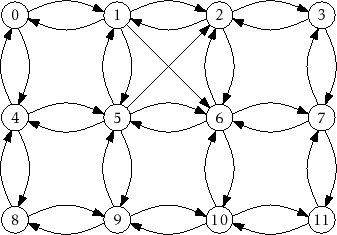Next: 12.1 : Representing a Up: Open Data Structures (in Previous: 11.3 Discussion and Exercises Contents
In this chapter, we study two representations of graphs and basic algorithms on these representations.
Mathematically, a (directed) graph is a pair ![]() where
where
![]() is a set of vertices and
is a set of vertices and ![]() is a set of ordered pairs
of vertices called edges. An edge
is a set of ordered pairs
of vertices called edges. An edge
![]() is directed
from
is directed
from
![]() to
to
![]() ;
;
![]() is called the source of the edge and
is called the source of the edge and
![]() is called the target. A path in
is called the target. A path in ![]() is a sequence of
vertices
is a sequence of
vertices
![]() such that, for every
such that, for every
![]() ,
the edge
,
the edge
![]() is in
is in ![]() . A path
. A path
![]() is a
cycle if, additionally, the edge
is a
cycle if, additionally, the edge ![]() is in
is in ![]() . A path (or
cycle) is simple if all of its vertices are unique. If there is
a path from some vertex
. A path (or
cycle) is simple if all of its vertices are unique. If there is
a path from some vertex ![]() to some vertex
to some vertex ![]() then we say that
then we say that ![]() is reachable from
is reachable from ![]() .
An example of a graph is shown in Figure 12.1.
.
An example of a graph is shown in Figure 12.1.

|
Graphs have an enormous number of applications, due to their ability to model so many phenomena. There are many obvious examples. Computer networks can be modelled as graphs, with vertices corresponding to computers and edges corresponding to (directed) communication links between those computers. Street networks can be modelled as graphs, with vertices representing intersections and edges representing streets joining consecutive intersections.
Less obvious examples occur as soon as we realize that graphs can model
any pairwise relationships within a set. For example, in a university
setting we might have a timetable conflict graph whose vertices represent
courses offered in the university and in which the edge
![]() is present
if and only if there is at least one student that is taking both class
is present
if and only if there is at least one student that is taking both class
![]() and class
and class
![]() . Thus, an edge indicates that the exam for class
. Thus, an edge indicates that the exam for class
![]() can not be scheduled at the same time as the exam for class
can not be scheduled at the same time as the exam for class
![]() .
.
Throughout this section, we will use
![]() to denote the number of vertices
of
to denote the number of vertices
of ![]() and
and
![]() to denote the number of edges of
to denote the number of edges of ![]() . That is,
. That is,
![]() and
and
![]() . Furthermore, we will assume that
. Furthermore, we will assume that
![]() .
Any other data that we would like to associate with the elements of
.
Any other data that we would like to associate with the elements of ![]() can be stored in an array of length
can be stored in an array of length
![]() .
.
Some typical operations performed on graphs are:
Note that these operations are not terribly difficult to implement
efficiently. For example, the first three operations can be implemented
directly by using a
![]() , so they can be implemented in constant
expected time using the hash tables discussed in Chapter 5.
The last two operations can be implemented in constant time by storing,
for each vertex, a list of its adjacent vertices.
, so they can be implemented in constant
expected time using the hash tables discussed in Chapter 5.
The last two operations can be implemented in constant time by storing,
for each vertex, a list of its adjacent vertices.
However, different applications of graphs have different performance requirements for these operations and, ideally, we can use the simplest implementation that satisfies all the application's requirements. For this reason, we discuss two broad categories of graph representations.